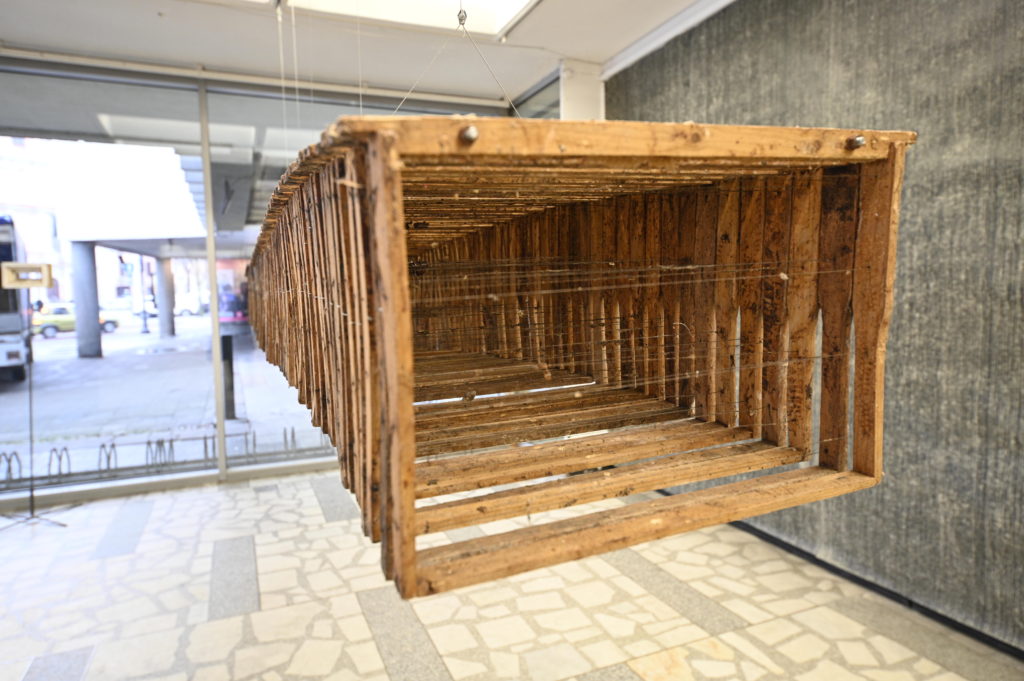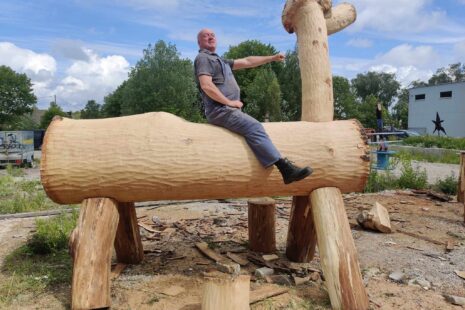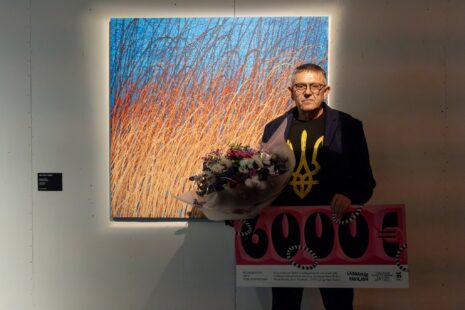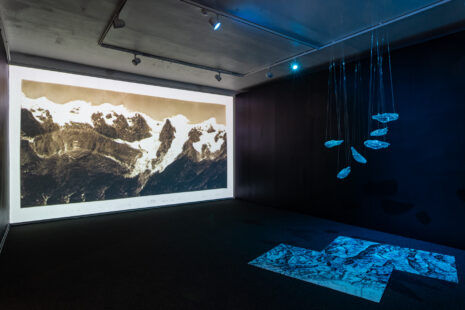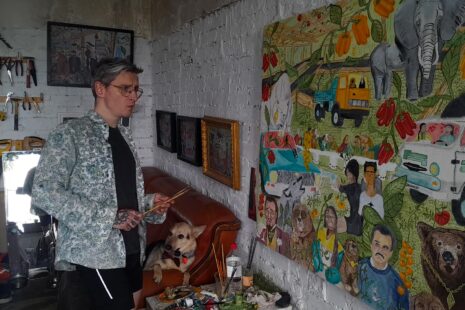HOW DOES AN ARTIST SMELL? Michalina Bigaji at Gallery AV17
No, it’s not like you think, an artist does not smell bad. Gallery AV17 introduced us to the artist Michalina Bigaj, who is fascinated by discovering moments where humans realise their incapability in relation to the power of nature accompanied by the feeling of longing to connect with it.
The exhibition is technically a sculptural installation, where different scents, including the both artist´s and her boyfriend’s are presented on a sculptural landscape made of ceramics.
Different smells are installed into ceramics, lotus flower for example, giving a fragile look to the whole composition.
The artist herself suffers under innate deficiency of odour sensitivity, having sensed no smells since her birth, neither does she have any memories related to odours. Research has demonstrated that humans who do not experience olfactory stimuli, have a greater risk of suffering from depression, sexual dysfunction, and are less likely to find a suitable partner. The deficiency of one of the senses causes the organism to adapt, so the ‘malfunction’ becomes unnoticeable, while for certain species of the animal world have lost their ability to perceive smells amounts to little chance of survival.
The artist’s main interest lies in increasingly deepening imbalance between contemporary civilisation and natural environment. Treating the world of nature as property, humans have already managed to subordinate it in a way that allows them to use it selectively.
The next exhibition in AV17 will open on January31th with Kaspars Podnieks show.
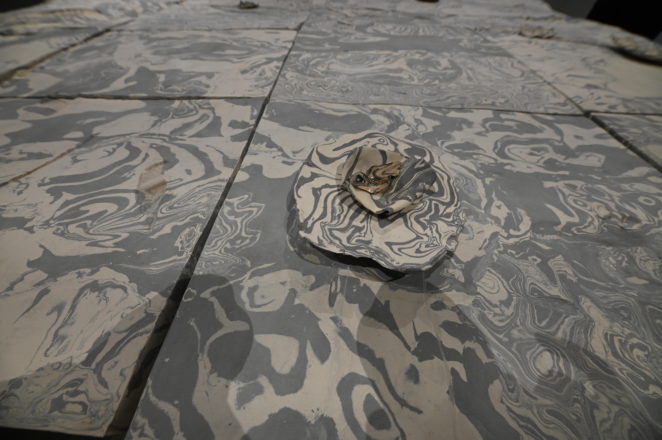
Gallery AV17 exhibition view Michalina Bigaji
Are dying bees and fading trees a new reality in our concrete forest?
“Human Factor. Fragments” at Artists’ Association Gallery
The subject of environment has been so overused, that it has become a slippery road for an artist not to appear cliché. The abrupt way the Lithuanian artist Andrius Erminas brings the subject viewers’ attention in the show „HUMAN FACTOR. FRAGMENTS“, left an unforgettable impression.
The artist has been engaged in the series “The Human Factor” already for nine years, naming said exhibition “Fragments”, bringing various daily objects, cultural artefacts and natural elements into space with the presence of strong historical architecture.
The whole exhibition carries a strong narrative, presenting the room as an integral unit while connecting different stories.
The exhibition plays on individual and collective memories while the items presented in the exhibition have a strong connection to history, referring to personal and collective memory. There are small details that refer to contradictory questions such as organical/industrial, nature/civilization, life and death.
Artists’ Association Gallery new show Angelina Banytė MONUMENTAL SILENCE will open on 16th of Feburary.
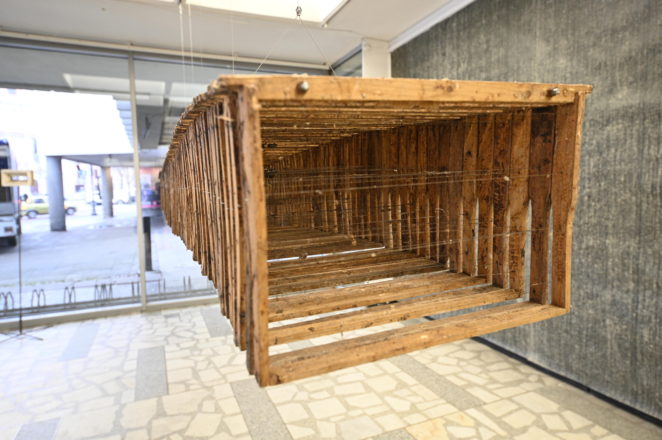
Andrius Erminas exhibition “Human Factor. Fragments” at Artists’ Association Gallery.
Have you looked at the formations of civilisation through typography? Can we make predictions based on media?
International Typography Biennial “Travelling Letters” in Titanikas, 2nd floor.
As we all know, it is always useful to ask the gallerist to give you a deeper insight or simply take time and read through the signs, provides the works with the right context. I had the pleasure of a quick guided tour with prof. Aušra Lisauskienė.
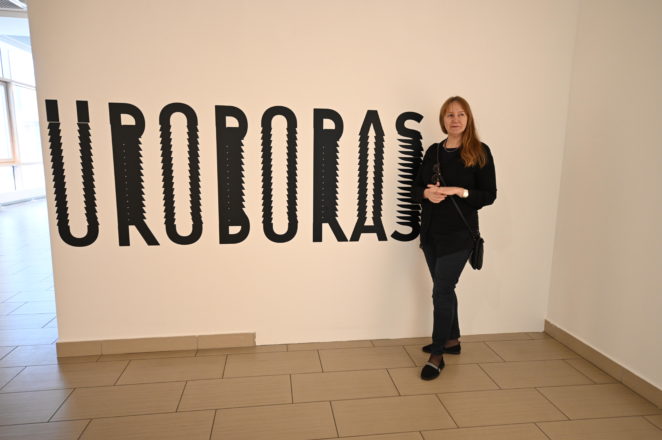
Typography Biennial “Travelling Letters” with prof. Aušra Lisauskienė
About the exhibition – scripture has often been used as a propaganda tool. The 2019 exhibition UROBOR invites to interpret and reveal how graphic symbols, letters, script, typography and modern tools in traditional or new media have evolved as typographic or similar tools.
Letters, writing, typography, along with other fundamental human inventions, contribute to the development of culture no less than other arts.
Oscar Spengler, “Cyclic civilization” states that civilizations exist cyclically- they are born, matured and extinguished. Each stage featuring its certain characteristics of spirit, art, and politics. The following stages of civilization development are described in the scheme – spring, summer, autumn, and winter. How did the letter adapt to this change?
The life and living of letters
The rusted sign of an old bookshop “Knygynas” is visible already through the window from the street. The artist Sigitas Gužauskas´ work “Light forest” transforms physical, material letters into immaterial digital objects – a screen with changing fonts. The inspiration came from a very famous bookshop in Vilnius established in 1971. It used to have a sign KNYGYNAS (Bookstore in Latvian) written in bold, wide letters on the facade. Like many other bookstores, it seized to exist physically, having moved to a digital space.
The artist explores the transformation of letter shapes in digital space. New possibilities of visual appearance have evolved making the law of physics is irrelevant. Digitalized letters are able to spread to thousands of screens in a microsecond, change their appearance, stretch, shrink, move, expand….
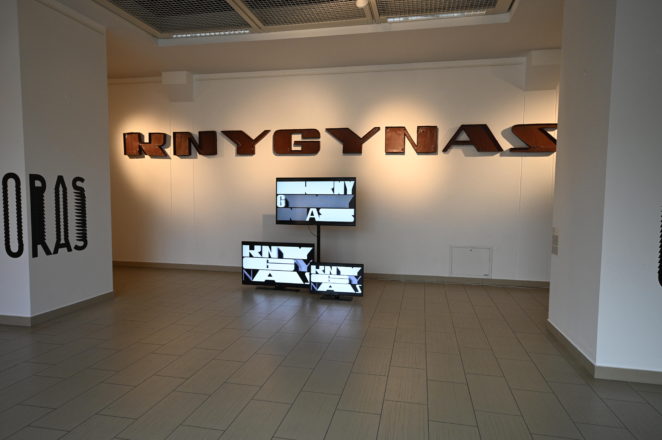
Sigitas Gužauskas´ work “Light forest”
The dancing letters of Eglé Ganda Bogdaniené and Jolanta Vazalinkiené in „Cuneiform – Samsara Signs / 2019“look funny and catchy to the eye, until you notice a more deeper concern. Dancers´ clothing seen in a video are energetically stretched out on the wall looking like a letter or a sign, constantly changing their meaning.
The artists state that the figure of the dancing woman represents the first written signs of ancient civilisations. The on-screen static and dynamic silhouettes create an impression of rhythmic movement in the flat space. What is the meaning encoded in the repetitive motion when the vibrantly rotating dancer stumbles, in an attempt to break out of the screen frame?
In Sanskrit, Samsara means the constant change of the world, the cycle of death and rebirth. The work “Cuneiform – Samsara Signs” looks at human presence in “timeless” space. In the confrontation of the Anthropocene, the “Age of a new human,” we have been experiencing a shift in science and culture. The changes in atmosphere dictate new forms of existence and everyday life.
Who is a human becoming now as they solve the mysteries of the Universe, whereas still remaining the greatest mystery himself?
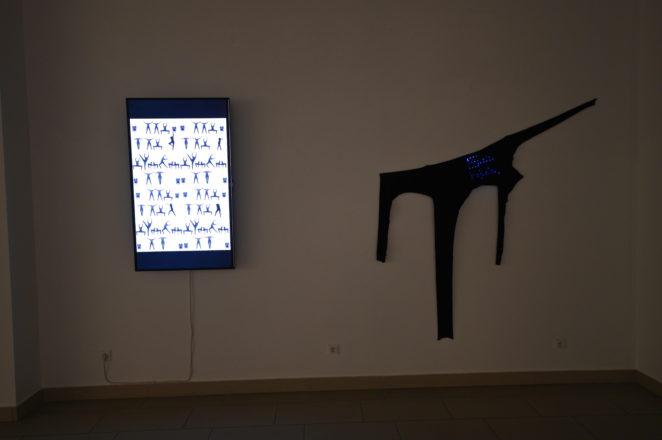
Eglé Ganda Bogdaniené and Jolanta Vazalinkiené in „Cuneiform – Samsara Signs / 2019
Marius Žalneravičius 3D animation „Is this a begining or just the end? / 2019“
Our civilisation is light years away from our predecessors from the Stone Age. Today we are capable of cultural homicide or suicide, without using a real physical weapon. We can take down a forest during one day, without torturing a tree for two months before that. We don’t eat dinosaur guts, but we eat pizza and a burger with a milk shake. Whether Alpha or Omega, you will never understand. We spin the wheel, digesting ourselves, wondering what to digest or not digest at all.
What made a primitive man feel creative?
How many parallels do we find in the construction of civilisations today compared to Stone Age? Have we changed at all or are we still using our proprietary creative platform, which was installed from The Beginning? Is it just the same knitting end or a new beginning? Knit being a metaphor to writing – to write down the subconscious, the deepest, most abstract form. Maybe civilisation is created from the subconscious, written down, knit from eternal threads. When a civilisation is broken, the threads remain and will be reused.
CAN YOU CRACK THE CODE?
VYGINTAS ORLOVAS. Titanikas, FIRST floor.
Titanikas first floor exhibits are showing the works by Vygintas Orlovas, an artist and researcher working in visual and audible art with the focus on the relations and connections of these two fields.
Vygintas Works are technically very well equipped and felt perfect in the current exhibition space. Interactive installations were easy to use and understand but lacked information in English which could mean missing out on nuances. Especially looking at his first work “In the entrance” one can see a book of codes: „nroxqkts, or a book from the library of Babel“. Being intrigued and searching his website I discovered that the book is based on the short story “Library of Babel” by one of the most influential authors of our time J. L. Borges. The book contains a description of the exhibition: “The meaning has changed even before saying the word” in one of its’ pages. Unfortunately, I could not read the rest of the exhibition code… If you speak Lithuanian, you are much welcomed to explain as we in NOAR are eager to crack the code.
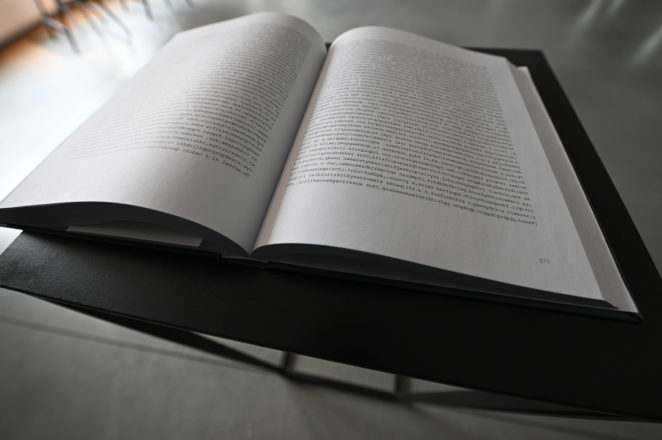
Vygintas Orlovas
Simple everyday physical things can shape your self-perception
“Alert Objects”, Vartai Gallery
As galleries are fighting to attract new audiences, the Vartai gallery exhibits a new series dedicated to contemporary design.
“Alert Objects”, the first exhibition in the series, features design projects by nine authors, many of the which being alumni of the Design Academy Eindhoven.
The title of the exhibition refers to the logical contradiction evident in our daily life: the things surrounding us are not just inanimate and passive signs of their time and culture, but rather have subjective qualities, impose their order, and shape our self-perception.
Although all of the exhibits are furniture items or interior elements with a specific function, they resist passive instrumental usage and demand a performative being-together relationship. They openly manifest their role in the complex field of semantic tensions in which they were created and operate constantly reminding the user that the aesthetic and functional value of things is inseparable from the ethical motives behind their creation.
The exhibition is curated by Vytautas Gečas and Marija Puipaitė.
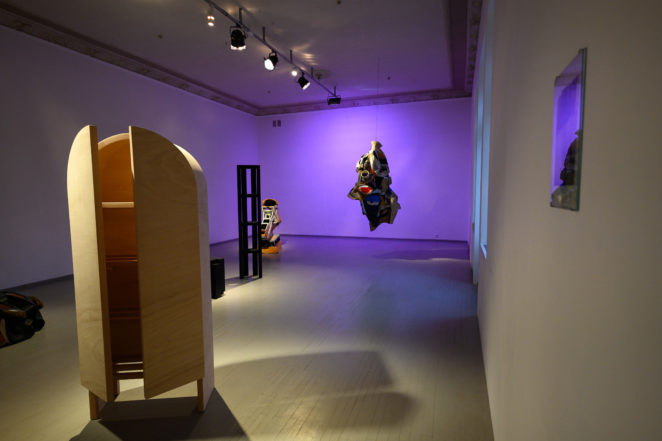
Exhibition view “Alert Objects” at Vartai Gallery
Visit NOAR event calendar to find exhibitions and art events in the Baltics!

